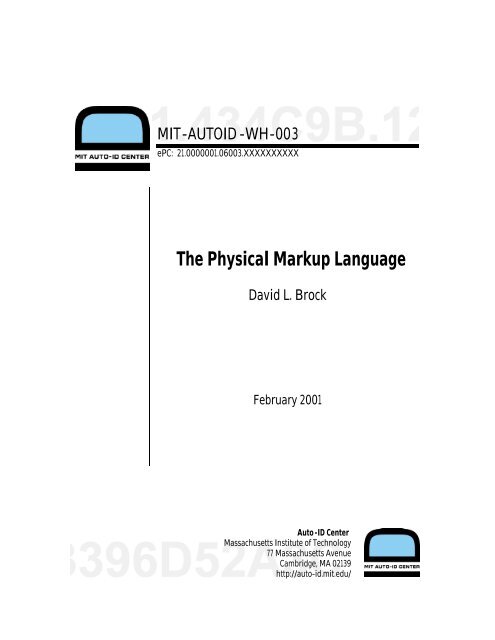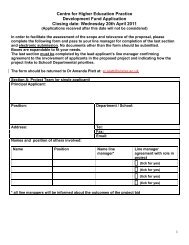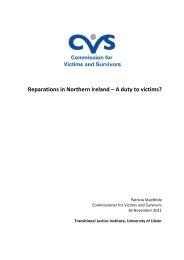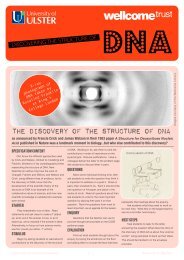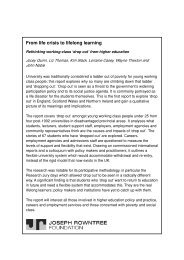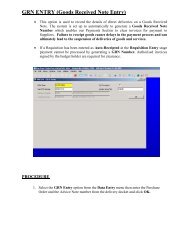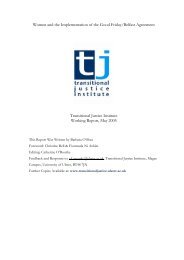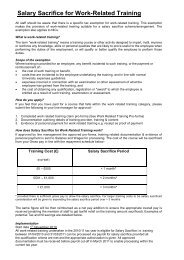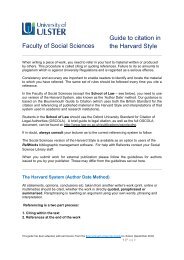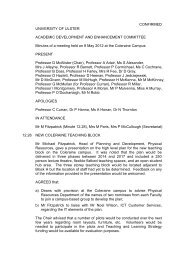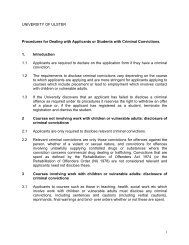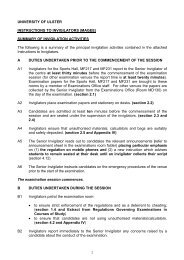The Physical Markup Language - Auto-ID Labs
The Physical Markup Language - Auto-ID Labs
The Physical Markup Language - Auto-ID Labs
You also want an ePaper? Increase the reach of your titles
YUMPU automatically turns print PDFs into web optimized ePapers that Google loves.
MIT-AUTO<strong>ID</strong> -WH-003<br />
ePC: 21.0000001.06003.XXXXXXXXXX<br />
<strong>The</strong> <strong>Physical</strong> <strong>Markup</strong> <strong>Language</strong><br />
David L. Brock<br />
February 2001<br />
<strong>Auto</strong> -<strong>ID</strong> Center<br />
Massachusetts Institute of Technology<br />
77 Massachusetts Avenue<br />
Cambridge, MA 02139<br />
http://auto-id.mit.edu/
Abstract – <strong>The</strong> <strong>Physical</strong> <strong>Markup</strong> <strong>Language</strong> (PML) is<br />
intended to be a common “language” for describing<br />
physical objects, processes and environments. Much<br />
as the Hypertext <strong>Markup</strong> <strong>Language</strong> (HTML) has<br />
standardized the way in which information is<br />
presented on the Internet, PML is designed to<br />
standardize descriptions of physical objects for use by<br />
both humans and machines. <strong>The</strong> primary objective of<br />
PML is to serve as a common base for software<br />
applications, data storage and analytic tools for<br />
industry and commerce. This paper presents some<br />
fundamental issues in the design of the language, as<br />
well as assumptions underlying its development and<br />
implementation.<br />
I. INTRODUCTION<br />
<strong>The</strong> <strong>Physical</strong> <strong>Markup</strong> <strong>Language</strong> (PML) is intended to<br />
be a general, standard means for describing the physical<br />
world. When we consider that human language performs<br />
a similar function, it is clear we must carefully consider<br />
the goals and objectives of PML for any hope of<br />
successful adoption.<br />
<strong>The</strong> objective of PML is a simple, general language<br />
for describing physical objects for use in remote<br />
monitoring and control of the physical environment.<br />
Applications include inventory management, automatic<br />
transaction, supply chain tracking, machine control and<br />
inter-object communication.<br />
Given the objectives of PML, the language should<br />
encourage the rapid development of software tools and<br />
applications. <strong>The</strong>refore, PML should be as simple as<br />
possible (at least in its initial implementation), yet as<br />
comprehensive as needed to provide general utility.<br />
As opposed to the many standards and languages,<br />
which have been successfully developed in specific<br />
application domains, the intention of PML is to provide<br />
broad definitions, describing those characteristics<br />
common to all physical objects. <strong>The</strong> assumption is that<br />
applications built on this language can be applied across a<br />
broad range of industries and businesses.<br />
In the following sections, we will present fundamental<br />
assumptions in the development of the <strong>Physical</strong> <strong>Markup</strong><br />
<strong>Language</strong> and discuss design approaches intended to<br />
achieve the objectives for the language.<br />
<strong>The</strong> <strong>Physical</strong> <strong>Markup</strong> <strong>Language</strong><br />
A Universal <strong>Language</strong> for <strong>Physical</strong> Objects<br />
David L. Brock<br />
<strong>Auto</strong>-<strong>ID</strong> Center<br />
Massachusetts Institute of Technology<br />
Cambridge, MA USA 02139<br />
II. BACKGROUND<br />
<strong>The</strong> intelligent infrastructure, which we envision,<br />
automatically and seamlessly links physical objects to<br />
each other, people and information through the global<br />
Internet [1]. This intelligent infrastructure has four major<br />
components: electronic tags, Electronic Product Code<br />
(ePC), <strong>Physical</strong> <strong>Markup</strong> <strong>Language</strong> (PML) and Object<br />
Naming Service (ONS).<br />
Electronic tags refer to a family of technologies that<br />
transfer data wirelessly between tagged objects and<br />
electronic readers. Radio Frequency Identification<br />
(RF<strong>ID</strong>) tags, often used in “smart cards,” have small radio<br />
antennas, which transmit data over a short range [2]. <strong>The</strong><br />
Motorola BiStatix tags, an Electromagnetic<br />
Identification (EM<strong>ID</strong>) technology, uses capacitive<br />
coupling to transmit information [3]. Electronic tags,<br />
when coupled to a reader network, allow continuous<br />
tracking and identification of physical resources. In order<br />
to access and identify tagged objects, a unique naming<br />
system was developed.<br />
<strong>The</strong> Electronic Product Code (ePC) was conceived as<br />
a means to identify physical objects [4]. <strong>The</strong> ePC code<br />
was created to enumerate all objects and to accommodate<br />
current and future naming methods. <strong>The</strong> ePC code was<br />
intended to be universally and globally accepted as a<br />
means to link physical objects to the computer network,<br />
and to serve as an efficient information reference.<br />
<strong>The</strong> Object Naming Service (ONS) is the “glue,”<br />
which links the Electronic Product Code (ePC) with its<br />
associated data file [5]. More specifically, the ONS is an<br />
automated networking service, which, when given an ePC<br />
number, returns a host addresses on which the<br />
corresponding data file is located. <strong>The</strong> ONS, currently<br />
under development, is based on the standard Domain<br />
Naming Service (DNS). When complete, the ONS will<br />
be efficient and scaleable, designed to handle the trillions<br />
of transactions that are expected.<br />
Finally, the <strong>Physical</strong> <strong>Markup</strong> <strong>Language</strong> (PML) is<br />
intended to be the standard in which networked<br />
information about physical objects is written. In one<br />
sense, all the complexity of describing and classifying<br />
objects has moved away from the object label and into the<br />
PML file. <strong>The</strong> formation of this language — together
with the associated software tools and applications — is<br />
one of the most difficult aspects of this “Internet of<br />
Things.”<br />
III. APPROACH<br />
<strong>The</strong> effective design of the <strong>Physical</strong> <strong>Markup</strong> <strong>Language</strong><br />
must balance a myriad of competing design issues and<br />
constraints. Since we have essentially eliminated most of<br />
the information and structure on the tagged object, all the<br />
complexity of description has moved to the networked<br />
database. Issues such as syntax, data types, complexity,<br />
extensibility, security, application domains, units of<br />
measure and more, must be weighted to effective achieve<br />
the objectives set out for the language.<br />
In the following sections, we will consider a variety of<br />
design issues, key assumptions and other considerations<br />
in the formation of the PML. This in not an exhaustive<br />
list, but a starting point in the language design.<br />
We must remember numerous languages and standards<br />
have developed in the past, yet few see wide spread<br />
adoption. We wish to avoid the pitfalls of the past, and<br />
develop a standard, which is simple, convenient and<br />
effective.<br />
A. Generality<br />
<strong>The</strong> objective the <strong>Physical</strong> <strong>Markup</strong> <strong>Language</strong> is to be a<br />
universal standard for describing physical objects,<br />
processes and environments. Clearly given the broad<br />
scope of this objective, the language cannot be overly<br />
detailed or specific. In the classic choice between depth<br />
and breath, the proposed PML will lean toward a more<br />
general standard, rather than industry specific<br />
implementations.<br />
<strong>The</strong>re are number of reasons for this decision. First, a<br />
broad language will address the largest number of<br />
industries. Second, software developed for the language<br />
will have the greatest potential market. <strong>The</strong> quality and<br />
capability of the code will likely be superior to any<br />
specific implementation. This is analogous to Web<br />
browsers, such as AOL’s Netscape or Microsoft’s<br />
Internet Explorer, both of which are generally superior<br />
to similar applications targeted for specific industries.<br />
<strong>The</strong> more generic software also tends to be more robust<br />
and less expensive than focused applications.<br />
Third, physical objects and systems do indeed have<br />
common, underlying characteristics. Since most physical<br />
objects of interest to industry and commerce are those<br />
designed and built by humans, they tend to have shared<br />
features, such as shape, symmetry, materials and function,<br />
as well as business processes, ownership and transaction.<br />
Furthermore, many industries, such as healthcare,<br />
manufacturing, defense, logistics, transportation, disposal<br />
and many others, describe similar characteristics in<br />
different ways. By offering a unifying language, these<br />
characteristics can be shared and translated across<br />
industry groups, multiplying the amount of available<br />
information. <strong>Auto</strong>mated, industry specific translators<br />
may be written allowing the shared information to be<br />
presented in familiar ways.<br />
Finally, a broad descriptive language will encourage a<br />
greater degree of industry cooperation and facilitate<br />
information sharing for mutual benefit. Often data, such<br />
as between a retailer and supplier, is not available simply<br />
because of lack of standards.<br />
B. Simplicity<br />
Many standards are not adopted because of their<br />
inherent complexity and steep learning curves involved in<br />
acquisition and implementation. Although the Standard<br />
General <strong>Markup</strong> <strong>Language</strong> (SGML) has existed for many<br />
years, it has not seen wide spread adoption in part<br />
because of its size and complexity [6, 7].<br />
Its derivative, the Hypertext <strong>Markup</strong> <strong>Language</strong><br />
(HTML), has, of course, seen phenomenal growth, in part<br />
because of its simplicity and because of the tools and<br />
viewers available for the standard [8]. <strong>The</strong> Extensible<br />
<strong>Markup</strong> <strong>Language</strong> (XML), also based on the Standard<br />
General <strong>Markup</strong> <strong>Language</strong>, has seen increasing growth as<br />
a tool for tagging data content [9]. <strong>The</strong> XML is a simple<br />
subset of the larger SGML and is readily accessible to the<br />
casual programmer.<br />
Thus complex standards and languages – even though<br />
powerful and effective – have slow learning curves and<br />
limited audiences than smaller, simple languages.<br />
<strong>The</strong>refore, even though the initial PML may be limited in<br />
scope, we propose a relatively simple language easily<br />
understood and adopted by a larger population.<br />
C. Adoption pathway<br />
Rather than a monolithic, immutable standard, we will<br />
assume the <strong>Physical</strong> <strong>Markup</strong> <strong>Language</strong> will proceed<br />
through a number of iterations. In fact, rather than a<br />
deficiency, this process can be advantageous. While a<br />
simple standard is being learned and adopted,<br />
modifications and extensions can be developed. In this<br />
way familiarity with the language can proceed along with<br />
its capability. In fact, this process may be necessary,<br />
since a complex language would not be learned and a<br />
simple language would not be sufficient.
Although the HyperText <strong>Markup</strong> <strong>Language</strong> (HTML)<br />
was a simple language and easily understood, it was, in<br />
its initial version, quite limited in scope and in power.<br />
Multiple versions and extensions followed once the<br />
significance and utility of the language were understood.<br />
Extensions, such as Cascading Style Sheets (CSS),<br />
Dynamic HTML, Flash Media and so on, were added to<br />
the basic capability.<br />
In the same way, we intend the initial PML<br />
specification to be limited in depth and power. By<br />
design, we will incrementally introduce extensions to<br />
increase its scope and functionality.<br />
D. Comprehensive data types<br />
We may consider the <strong>Physical</strong> <strong>Markup</strong> <strong>Language</strong> to<br />
have different ‘types’ of data – static, temporal, dynamic<br />
and algorithmic. <strong>The</strong>se types will not be defined<br />
explicitly in the specification, but are useful distinctions<br />
when discussing the language.<br />
Static data is information, which essentially remains<br />
constant through the life of the object, such as material<br />
composition, geometry and physical properties.<br />
Temporal data is that information which changes<br />
discreetly and intermittently throughout an object’s life.<br />
<strong>The</strong>se may include configuration or location. For<br />
example, the location of an object on a shelf or whether a<br />
part is attached to an assembly, are examples of this type<br />
of data. <strong>The</strong>se data must be associated with a time and<br />
duration to record the temporal configuration of the<br />
environment.<br />
Dynamic data is information that varies continuously.<br />
<strong>The</strong> temperature of a shipment of fruit or the EKG from a<br />
heart monitor are examples of dynamic data. Unlike most<br />
database systems these data must be cached and<br />
transmitted intermittently to limit the network bandwidth<br />
and to provide only the most relevant and necessary<br />
information.<br />
Finally, algorithmic data includes simulation models,<br />
system processes and software associate with a physical<br />
object. Not all physical properties can be described by a<br />
simple number. For example, the expiration data on a<br />
perishable item may be a complex calculation involving<br />
temperature history, humidity and ambient light.<br />
Cooking instructions could be another example. Heating<br />
profiles depend on personal preference, food type and<br />
quantity, atmospheric pressure, ambient temperature and<br />
oven type.<br />
<strong>The</strong>se designations – static, temporal, dynamic and<br />
algorithmic – are simple different views of the same data.<br />
A static description such as the shape of a glass would be<br />
temporal if it hit the floor. <strong>The</strong> variation of viewpoint<br />
just depends of time scale and complexity of description.<br />
<strong>The</strong>refore, we will allow time variation on all data<br />
descriptions.<br />
E. Abstract nomenclature<br />
Clearly if we hope for a broad application of this<br />
language, we cannot expect familiar names for all<br />
physical properties. For example, “harvest time” for<br />
produce or “assembly time” for an automobile, may be<br />
replaced by a more generic “configuration” plus<br />
“timestamp.” Generally, we will use abstract names to<br />
describe a wider range of physical systems and processes,<br />
rather than industry specific descriptions.<br />
Why use abstract notation? <strong>The</strong> answer is – when we<br />
consider the primary objective of the language – to<br />
provide a convenient, high-level description for software<br />
and application development. More generic terms allow<br />
more powerful, general-purpose software to analysis<br />
similar configurations independent of industry specific<br />
nomenclature.<br />
F. Robust operation<br />
Unlike most Web pages, PML files will be much more<br />
dynamic and have a greater degree of connection to other<br />
network files and data streams. Object position, physical<br />
state and material descriptions will likely be in multiple<br />
data files scattered over the network. General physical<br />
properties, such as material and chemical information,<br />
will likely be stored in common repositories. Material<br />
Safety Data Sheets (MSDS) are good examples of this<br />
type of data.<br />
<strong>The</strong> PML language, together with associated tools and<br />
applications, will have to operate robustly with<br />
incomplete and intermittent information. Its operation<br />
may be similar to streaming image systems do today.<br />
G. Facilitate data archives<br />
Although Web pages change frequently, PML data<br />
files will change even more rapidly. History files and<br />
efficient archiving will therefore be critical important.<br />
<strong>The</strong> temperature history of a perishable item,<br />
administration of drug or stress on structure must be<br />
carefully recorded and maintained.<br />
<strong>The</strong> PML data format will have to provide simple and<br />
convenient methods for associating time with data and for<br />
denoting periodic and continuous data.
H. Standard units of measure<br />
For much of recorded history, physical states of matter<br />
have been compared to known references. From cubits to<br />
nanometers from stones to dekagrams, multiples of<br />
common standards provide the means of communicating<br />
physical properties. A difficulty arises when different<br />
countries, groups, organizations and people use different<br />
and competing standards.<br />
Our desire for the <strong>Physical</strong> <strong>Markup</strong> <strong>Language</strong> to be a<br />
global standard must be weighed against the utility and<br />
convenience for the user. In particular we must decide on<br />
a method for recording data and units, and converting it<br />
from one system to another as necessary.<br />
Fundamental physical properties of matter – length,<br />
mass, time, force, velocity, density, magnetic field,<br />
luminosity and temperature – must be described precisely<br />
to be communicated effectively. Many physical<br />
properties are not independent. Speed, for example, is the<br />
ratio of length to time. Certain quantities must be<br />
selected as fundamental, while others derived.<br />
Fortunately, these issues have been resolved by<br />
standards bodies, such as the International Bureau of<br />
Weights and Measures (Le Système International<br />
d’Unités – SI) in conjunction with others such as the<br />
Nation Institute of Standards and Technology in the<br />
United States. <strong>The</strong> seven quantities selected as the basis<br />
of the International System of Units, abbreviated SI, were<br />
selected, and are shown in Table 1. Furthermore, all<br />
other units can be described by multiples or ratios of<br />
these units. Pressure, for example, is given by m -1 · kg · s -2 .<br />
Finally, names for common combinations, such as<br />
Pascals for the pressure given above, are provided under<br />
the SI system.<br />
Base Name Symbol<br />
Length meter m<br />
Mass kilogram kg<br />
Time second s<br />
Current Ampere A<br />
Temperature Kelvin K<br />
Amount Mole mol<br />
Intensity Candela cd<br />
Table 1. <strong>The</strong> seven SI base units assure mutual<br />
independent, unambiguous measurement [10].<br />
Although the above discussion is fine for scientific<br />
precision of weights and measures, we have the practical<br />
problem describing physical properties in the multiple<br />
common systems people use today. Considering the<br />
options, we may allow PML to use any standard<br />
–International System, British or other. We may also<br />
allow any designation of unit, such as “kilograms,” “kgs”<br />
or “Kg.” This makes the creation of PML files easy,<br />
since any standard of measure written in any language<br />
and with any abbreviation may be used. <strong>The</strong> software<br />
tools that must process these data files, however, must be<br />
complex, since they must recognize and translate any<br />
arbitrary designations.<br />
On the other hand, if we rigidly dictate a particular<br />
standard in a single language, we have difficulty in<br />
readability and usage. Each PML application must<br />
translate units into their common, local standards. In the<br />
whole, translating from a known standard to another is<br />
easier then converting from an unknown, arbitrary<br />
language.<br />
From this reason, it seems likely PML will adopt a<br />
single system for weights and measures, with particular<br />
designations, and rely on the software tools to provide<br />
common translations. Furthermore, common translation<br />
software can be accessed and shared from the network.<br />
This creates smaller, more easily understood data files,<br />
which are precise and accessible. Further, we will rely<br />
on the years of effort by the many standards bodies to<br />
prescribe these systems.<br />
I. Fundamental and derived data<br />
Many schemes used to store information include<br />
redundant and derived data. As much as possible, the<br />
PML language should not provide any data that can be<br />
calculated or inferred from other data. Unit conversion<br />
for example may be computed by a client application,<br />
remote server, or perhaps by a dedicated<br />
conversion/computation system.<br />
J. Standard Syntax<br />
Rather than reinvent a new syntax for the <strong>Physical</strong><br />
<strong>Markup</strong> <strong>Language</strong>, we propose to use the extensible<br />
<strong>Markup</strong> <strong>Language</strong> (XML). Although different syntactic<br />
representations could be used, XML has been well<br />
defined and in general use as a simple method for<br />
embedded meta-data in flexible database structures.<br />
Furthermore, the extensions, such as the XML Query<br />
specification, provide a uniform and simple method for<br />
accessing data through Simple Query <strong>Language</strong> (SQL)<br />
notation [11]. In addition, general utilities, tools and<br />
validation software exist to parse, modify and access<br />
XML files.<br />
<strong>The</strong> <strong>Physical</strong> <strong>Markup</strong> <strong>Language</strong> (PML) will therefore<br />
be – at least initially – an XML scheme, described in any<br />
of the common schema languages, such as the Document
Type Declaration (DTD), Resource Description<br />
Framework (RDF) and others [9, 12].<br />
K. Global language<br />
As with current trends in standards development and<br />
network languages, we will attempt to craft PML as a<br />
global standard and avoid national terms and descriptions.<br />
We will rely on existing standards bodies, such as the<br />
Uniform Code Council (UCC), the European Article<br />
Number (EAN) Association, the American National<br />
Standards Institute (ANSI) and the International<br />
Standards Organization (ISO), as well as commercial<br />
consortium and industry groups, to aid in the definition of<br />
the language.<br />
L. Facilitate application development<br />
One of the primary purposes of the <strong>Physical</strong> <strong>Markup</strong><br />
<strong>Language</strong> is to facilitate the development of software<br />
applications. <strong>The</strong>refore, we must design PML with<br />
consideration for the needs and requirements of<br />
application programmer.<br />
Almost all the issues discussed so far relate to this<br />
objective. Widely adopted, simple languages encourage<br />
application development and ease the programming task.<br />
Extensions and enhancements to an established language<br />
will be paralleled by modifications to existing code.<br />
Simple, unambiguous nomenclature reduces the<br />
complexity of the PML parser and uniform units for<br />
weights and measures ease the burden of software<br />
translators. Finally, common, globally accepted syntax,<br />
such as XML, together with software libraries, such as the<br />
JAVA DOM and SAX packages, provide useful tools for<br />
the software developer [13].<br />
<strong>The</strong> design of the <strong>Physical</strong> <strong>Markup</strong> <strong>Language</strong> will<br />
accommodate the application developer and provide the<br />
systems and tools to facilitate their efforts. As future<br />
versions of the PML become available, we will streamline<br />
the semantics to speed software upgrades and new<br />
applications.<br />
A. Overview<br />
IV. DESIGN<br />
In the following subsections, we will consider<br />
characteristics common to physical objects, for the<br />
purposes of forming a basis for the <strong>Physical</strong> <strong>Markup</strong><br />
<strong>Language</strong>. <strong>The</strong> physical features considered are by no<br />
means exhaustive, but serves as simply starting point for<br />
the general design of the language.<br />
B. Hierarchy<br />
<strong>Physical</strong> objects often display some degree of<br />
regularity and organization. A fundamental type of<br />
organizational structure is hierarchy – the composition of<br />
parts and subparts. We think of machines having<br />
assemblies, systems, subsystems and parts, as illustrated<br />
schematically in Figure 1. <strong>The</strong>se hierarchical descriptions<br />
apply not only to assemblies, but also to aggregates and<br />
collections. A tea set, for example, may be comprised of<br />
cups, saucers and spoons, yet have no physical<br />
connection.<br />
Even natural objects have hierarchical structure. <strong>The</strong><br />
tree being the classic example – having a root, trunk,<br />
branches and leaves. This characteristic of natural and<br />
man-made objects to exhibit a hierarchical structure<br />
should be included in any language of the physical world<br />
Assembly<br />
Systems<br />
Subsystems<br />
Parts<br />
Figure 1. <strong>Physical</strong> objects – both natural and man-made –<br />
often display a hierarchical structure.<br />
Beyond simple containment, the relationship between<br />
a parent and child object is often critical in describing the<br />
physical system. <strong>The</strong>se relationships exist not only up<br />
and down the hierarchical tree, but also across sibling<br />
elements. A mechanical joint is a good example.<br />
Kinematic pairs, including revolute, prismatic and ball-insocket<br />
joints, are often used to describe the coupling<br />
between elements in a mechanical system. A bolt,<br />
illustrated abstractly in Figure 2, shows how this may be<br />
done.
Figure 2. A bolt assembly, which consists of a bolt, washer<br />
and nut, may be thought of as a hierarchy with well defined<br />
relations between elements.<br />
Elements in the supply chain can also be thought of<br />
as an assembly. <strong>The</strong> transport vehicle, pallet, container<br />
and item form elements in a linked hierarchy, as shown in<br />
Figure 3. In this case, we explicitly define the pallet and<br />
pallet assembly as separate elements. A pallet, for<br />
example, would be considered a discrete item for a pallet<br />
logistics company, but a shipping unit for a transport<br />
company. It is important when developing the <strong>Physical</strong><br />
<strong>Markup</strong> <strong>Language</strong> to provide unambiguous descriptions<br />
for all possible users.<br />
Pallet<br />
Item 1, ...., Item 100<br />
EPC 01.000501.0008BF.0000005025<br />
Pallet shipment<br />
EPC 01.0037F2.001508.000319F827<br />
EPC 01.0003F2.00105D.0000039844<br />
EPC 01.000501.0008BF.0000005026<br />
EPC 01.000501.0008BF.0000005027<br />
EPC 01.000501.00017C.0000001139<br />
EPC 01.000501.00017C.000000113A<br />
Package EPC 01.000501.00017C.000000113B<br />
Package<br />
Package<br />
EPC 01.000501.001384.0000013EC<br />
EPC 01.000501.001384.000001450<br />
Figure 3. Elements in a shipment form a hierarchy composed<br />
of a transport vehicle, pallets, containers and items<br />
It is important to note, these hierarchies change over<br />
time. Links are continually forming and breaking.<br />
Consider a shipment loaded from a truck into a<br />
warehouse. <strong>The</strong> virtual link describing this assembly<br />
disassociate from the truck and reform with the<br />
warehouse. <strong>The</strong> transition in structure may trigger<br />
events, such as a change of ownership or responsibility,<br />
or perhaps a financial transaction such as a payment or<br />
refund.<br />
<strong>The</strong> transport vehicle, pallets, packages and items, in<br />
the previous example, form a hierarchy of four levels.<br />
Suppose, however, we had considered the entire shipping<br />
fleet, or, conversely, included the contents of every<br />
shipped item.<br />
Clearly different levels of detail are needed for<br />
different users and applications. <strong>The</strong> level of detail<br />
depends on the observer of the data. <strong>The</strong> concept of<br />
viewer dependent description will underlie the<br />
presentation of PML information.<br />
C. Classification and Categorization<br />
Perhaps one of the greatest challenges in describing<br />
physical objects is classification and categorization.<br />
Within the <strong>Physical</strong> <strong>Markup</strong> <strong>Language</strong>, we must include<br />
data structures and formats that provide efficient methods<br />
for classifying objects. <strong>The</strong>re are, of course, many<br />
previously developed standards and languages that<br />
provide this capability.<br />
In object oriented programming languages, such as<br />
C++, JAVA and ADA, as well as modeling tools, such as<br />
the Uniform Modeling <strong>Language</strong> (UML), there is an<br />
emphasis on building efficient class hierarchies [17].<br />
A classic example is “the apples and oranges.” In this<br />
example, an ‘apple’ and ‘orange’ are a type-of ‘fruit’, and<br />
a ‘fruit’ is a type-of ‘food,’ as illustrated in Figure 4.<br />
Figure 4. Classification and generalization are important<br />
functions for any language describing the physical world.
<strong>The</strong>re are, however, many different ways to classify<br />
objects – and this is the real problem. We might say an<br />
‘apple’ and a ‘stop sign’ are a type-of ‘round red shape’,<br />
which are a type-of ‘red object’. This would be critical,<br />
for example, if you suffered from red-green color<br />
deficiency. This is not a singular example. <strong>The</strong>re are,<br />
perhaps, as many ways to classify the physical world as<br />
there are people to observe it.<br />
<strong>The</strong> important point here is that classification depends<br />
on a particular viewpoint. <strong>The</strong> <strong>Physical</strong> <strong>Markup</strong><br />
<strong>Language</strong> will have to accommodate multiple<br />
classification schemes for identical physical attributes.<br />
This classification list will help the application<br />
software organize, filter and present particular<br />
characteristics of the physical world. Different views of<br />
the same data can be presented to different individuals at<br />
different times. A distributor may view the data in terms<br />
of shipment size, a retailer in terms of product movement,<br />
a consumer by price and a recycler by toxicity.<br />
In addition to classification within a particular PML<br />
file, object descriptions may subscribe to shared<br />
categorization schemes. In other words, common themes,<br />
such as material type, product class, storage system and<br />
recycling method, may be shared globally by the object<br />
description files.<br />
D. Component description<br />
At some point the description of the physical world<br />
must include the idea of a “part.” In other words, an<br />
irreducible element composed of essentially homogeneous<br />
material. We may consider parts to be the “nutsand-bolts”<br />
of an system, which may be literally nuts and<br />
bolts, the liquid in a container or the gas in a cylinder.<br />
Descriptions of solid objects are well represented in<br />
computer languages, for example the Virtual Reality<br />
Modeling <strong>Language</strong> (VRML), the ParaSolids TM modeling<br />
core and many others [14-16]. Generally, these include<br />
Boolean solid geometry, polyhedral models and smooth<br />
surfaces.<br />
Perhaps less well represented in current languages are<br />
descriptive tools for flexible planar objects, such as paper,<br />
film and clothing. Although the exact geometry of the<br />
material is often unimportant, the planar pattern and<br />
overall configuration are useful to describe. <strong>The</strong> planar<br />
shape may be described by two-dimensional geometry<br />
and thickness; however, the overall configuration of the<br />
sheet is more difficult to describe. Folding patterns,<br />
wrinkle and knotting, for example, may be useful for a<br />
laundry. <strong>The</strong> language for these objects must evolve<br />
needs of the application.<br />
Flexible linear objects are common, yet are not well<br />
represented in formal languages. <strong>The</strong>se include thread,<br />
cord, rope, wire, conduit and cable. As with planar<br />
objects, the cross-sectional geometry of linear objects is<br />
relatively easy to describe. <strong>The</strong> linear geometry, however,<br />
is more difficult to represent. Exact geometry may be<br />
needed for some objects, such as piping, but unnecessary<br />
for others, such as cables and rope.<br />
For geometric representation, PML will use establish,<br />
well-described languages, and extend these as needed for<br />
particular applications.<br />
E. Ascribed Information<br />
In addition to intrinsic information about an object, the<br />
<strong>Physical</strong> <strong>Markup</strong> <strong>Language</strong> must accommodate data<br />
ascribed to an object. This type of information includes<br />
names, titles, ownership, responsibility, cost and value.<br />
To a large degree, PML will use the extensive work<br />
already developed in this domain, particularly from<br />
electronic commerce initiatives, such as ebXML and<br />
UDDI [17, 18]. As much as possible, we will cooperate<br />
with these organizations to provide consistent and<br />
seamless integration with existing standards and<br />
languages.<br />
F. Process and models<br />
<strong>The</strong> physical world is characterized not only by the<br />
static arrangement of objects, but also by changes in these<br />
objects over time. <strong>The</strong> concept of process, that is the<br />
continuous change in the environment over time, is<br />
central to the concept of work. In addition, the<br />
anticipation changes or the projection of possible<br />
outcomes is planning. Although not in the initial<br />
implementations, the <strong>Physical</strong> <strong>Markup</strong> <strong>Language</strong> must<br />
eventually include descriptions process plans, schedules<br />
and timelines.<br />
V. CONCLUSION<br />
This paper proposes the concept of a united language<br />
for describing physical objects. We have presented some<br />
general guidelines, key assumptions and fundamental<br />
components of the language. From the initial<br />
specification through subsequent versions, we must<br />
evaluate breath and complexity relative to user benefit<br />
and industrial application. Clearly the successful<br />
standard is one that is used widely and applied<br />
effectively.
VI. REFERENCES<br />
1. “<strong>The</strong> Networked <strong>Physical</strong> World - Proposal for Engineering<br />
the Next Generation of Computing, Commerce and<br />
<strong>Auto</strong>matic-Identification,”<br />
http://auto-id.mit.edu/pdf/MIT-.AUTO<strong>ID</strong>-WH-001.pdf<br />
2. Radio Frequency Identification (RF<strong>ID</strong>) summary from the<br />
AIM Global Network (http://www.aimglobal.org).<br />
http://www.aimglobal.org/technologies/rfid/<br />
3. Motorola BiStatix Technology<br />
http://www.motorola.com/GSS/SSTG/smartcard/3_0_bst_home.htm<br />
http://www.motorola.com/GSS/SSTG/smartcard/white_papers/BiSta<br />
tix_Whitepaper.pdf<br />
4. Brock, D. L, “<strong>The</strong> Electronic Product Code – A Naming<br />
Scheme for <strong>Physical</strong> Objects,” <strong>Auto</strong>-<strong>ID</strong> White Paper, WH-<br />
002<br />
http://auto-id.mit.edu/pdf/MIT-AUTO<strong>ID</strong>-WH-002.pdf.<br />
5. <strong>The</strong> Object Naming Service (ONS) summary from the MIT<br />
<strong>Auto</strong>-<strong>ID</strong> Laboratory<br />
http://auto-id.mit.edu/research/naming.html.<br />
6. SGML Overview and references.<br />
http://www.oasis-open.org/cover.<br />
1. St. Laurent, Simon, “XML: A Primer, 2 nd Edition,” MIS<br />
Press, New York, 1999.<br />
8. <strong>The</strong> HyperText <strong>Markup</strong> <strong>Language</strong> (HTML) Specification<br />
World Wide Web Consortium<br />
http://www.w3.org/<strong>Markup</strong>.<br />
9. <strong>The</strong> Extensible <strong>Markup</strong> <strong>Language</strong> (XML) Specification<br />
World Wide Web Consortium<br />
http://www.w3.org/XML.<br />
10. <strong>The</strong> International System of Units (SI) from the National<br />
Institute of Standards and Technology (NIST)<br />
http://www.nist.gov<br />
http://www.nist.gov/cuu/Units/units.html.<br />
11. <strong>The</strong> Extensible <strong>Markup</strong> <strong>Language</strong> (XML) Query<br />
Specification<br />
World Wide Web Consortium<br />
http://www.w3.org/XML/Query/<br />
12. <strong>The</strong> Resource Description Framework (RDF) Specification<br />
World Wide Web Consortium<br />
http://www.w3.org/RDF.<br />
13. <strong>The</strong> Document Object Model (DOM) and the Simple API<br />
for XML (SAX)<br />
World Wide Web Consortium<br />
http://www.w3.org/XML/DOM.<br />
http://www.w3.org/XML/SAX/<br />
14. <strong>The</strong> Virtual Reality Modeling <strong>Language</strong> (VRML)<br />
http://www.web3d.org/technicalinfo/specifications/vrml97/in<br />
dex.htm<br />
from the Web3D Consortium<br />
http://www.web3d.org/.<br />
15. UGS Corporation, Parasolid TM modeler<br />
http://www.ugs.com/products/parasolid/.<br />
16. Foley, van Dam, Feiner, and Hughes, Computer Graphics:<br />
Principles and Practice, Addison Wesley, Reading, MA,<br />
1990.<br />
17. Unified Modeling <strong>Language</strong> Resource Center<br />
http://www.rational.com/uml/.<br />
18. ebXML electronic commerce language<br />
http://www.ebxml.org.<br />
19. Universal Description, Discovery, and Integration (UDDI)<br />
http://www.uddi.org.


